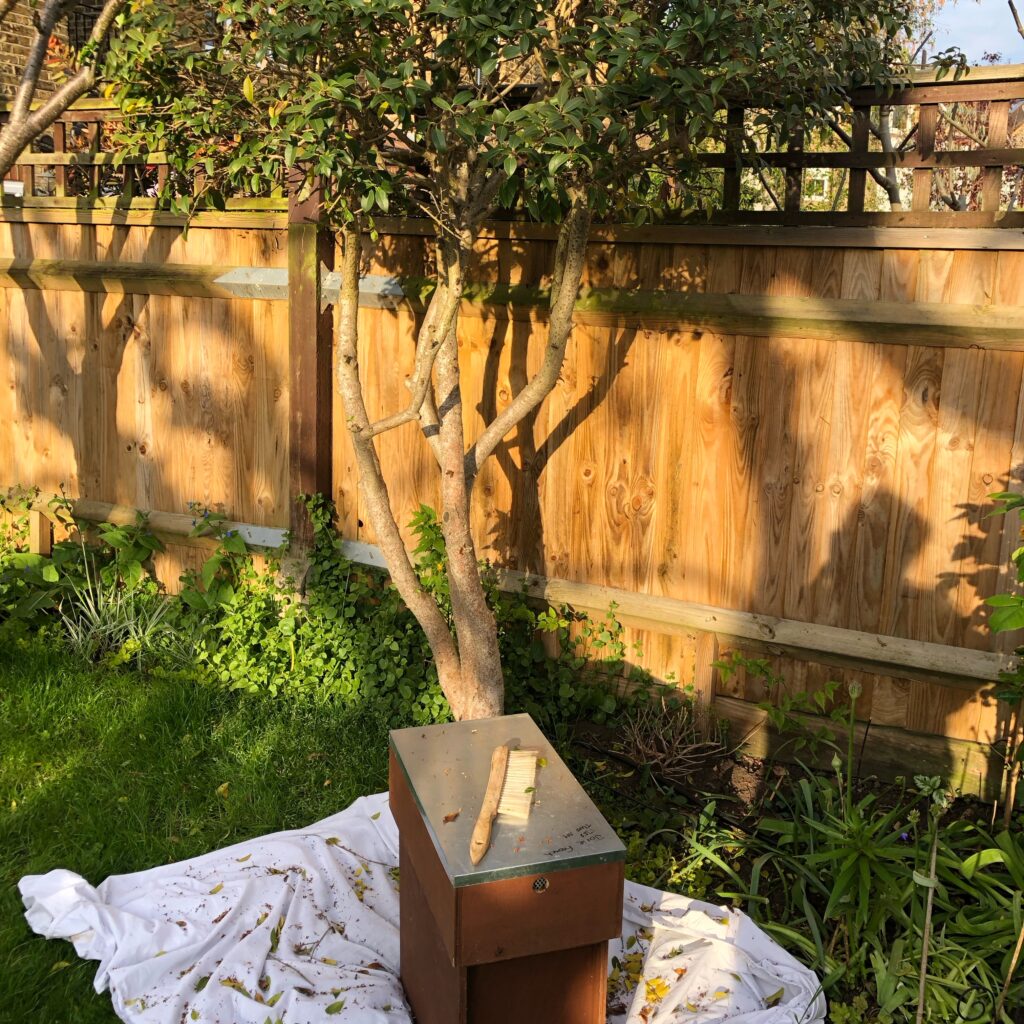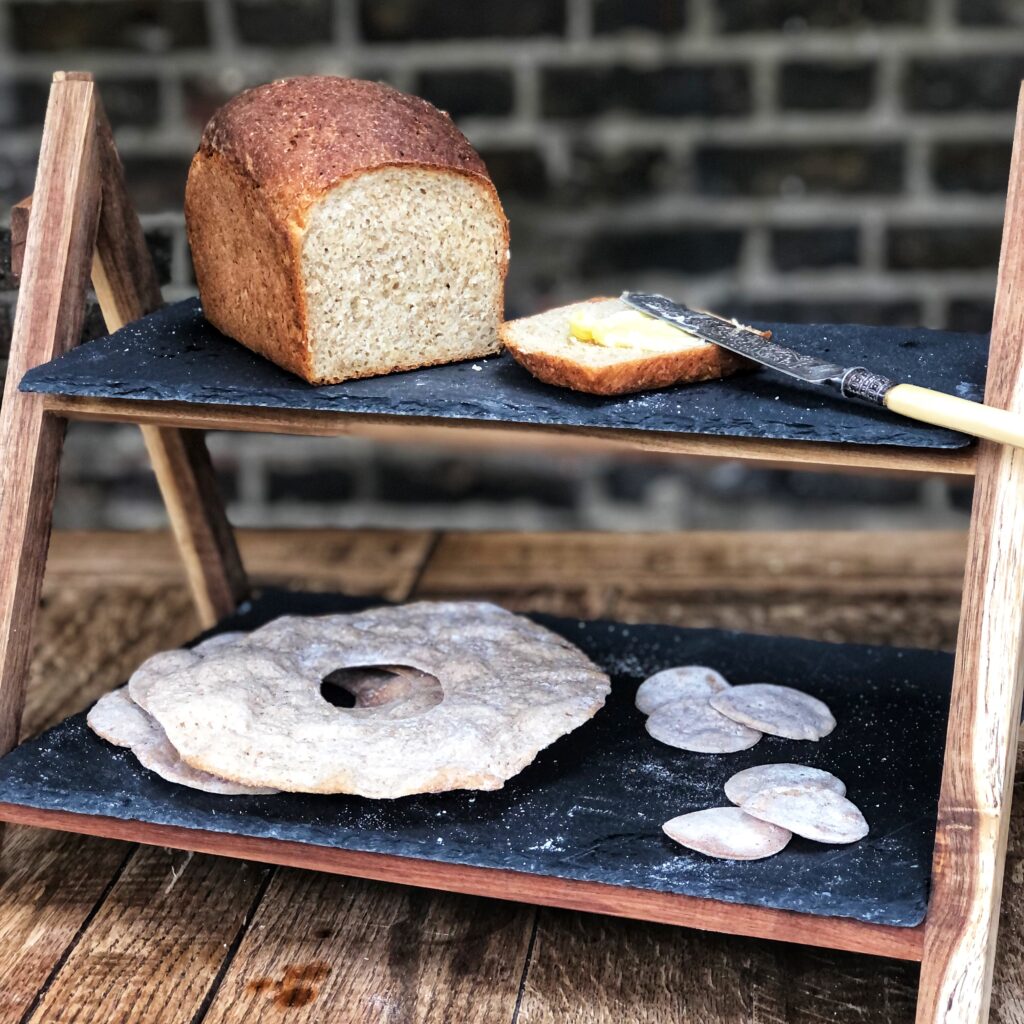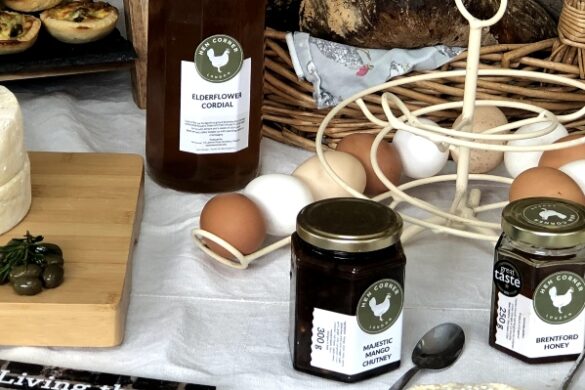Last month, we had our first Full Day Bee Keeping course and, as we went through each of the three colonies in the garden, I explained to our guests that it can take a while for them to build up after winter. Fortunately, this didn’t lead to complacency as within three days, another of our colonies was planning to swarm…
Glossary of terms:
- Bee = A single bee
- Colony = A family of bees (up to 60,000 bees in the summer!)
- Hive = A home for bees (might not have bees living in it all the time), we use three types of hives made of wood, plastic or polystyrene
- Apiary = A site/location where bee hives are kept and bees are cared for
- Swarm = A sub-colony of bees that have left the parent hive looking for a new home
I keep bees in three locations around Brentford, here at Hen Corner, at our riverside allotment and in the garden of a charity (that happens to be halfway between home and the plot). Between these three apiaries I had just 5 colonies and, within 18 days, I now have NINE!
A couple of weeks ago I had a quick look at the colony on the allotment and I was so pleased that I had for a few reasons:
First, the winter bees that had died in the hive had blocked the entrance so the foraging bees looking for nectar had to squeeze through holes that weren’t really big enough for them, I cleared the dead bees away leaving the others free to fly as and when they wanted.
Second, I discovered how established the colony was compared to my ‘slow to build up’ colonies at home, I knew that weekly inspections would now be needed to monitor their activity over the coming months.
Third, the findings above motivated me to pop into the charity garden on my way home to check on their bees and, if I hadn’t, they would have split and swarmed to ‘who knows where?’
On opening that hive, there were so many bees that I had to shake them off the internal frames before I could see anything, and when I did, found that they were rearing new queens in long sculptured cells in preparation to become two colonies. Fortunately, by spotting this before the original queen bee swarmed with up to half the colony, I was able to ‘artificially swarm’ them, by moving the old queen along with frames containing half the brood (eggs and larvae) and food (nectar and pollen) of the parent colony into a new hive. Phew! I hadn’t lost any and they should be happy for a while now.

Now that we’ve had a few warm sunny days, it seems that the valves have been opened on many a bulging hive sending huge clouds of bees looking for new ‘forever homes’. Experienced bee keepers, who are more than aware of the challenges of bee swarms especially in an urban environment, encourage weekly inspections of colonies so that we can reduce the risk of us losing our bees and allowing them to potentially cause havoc where they are not wanted. This week I’ve been called out to collect two such swarms of bees, the first had left their parent colony that is living in a chimney of a lovely semi-detached house in Ealing, these are the bees at the top of this post – can you spot the queen? The second swarm was in a small tree in a back garden in Kew, it was quite easy to knock most of them into a nuc box (half hive) and we didn’t have to wait long for the final flying bees to smell the queen bee’s pheromone and follow their sisters in, pictured above.

This new family of bees went straight to the allotment, above, and have already started to build up nicely as the nearby forage is yielding plenty of nectar allowing them to make wax to create new cells for the queen to lay eggs in and start a whole new family. Ironically, this second swarm call came literally minutes after I’d split the colony at the allotment, so we went from one colony to three on the plot in just a few hours…
Back in the kitchen , I’ve been practising some Nordic recipes for a new course: Introduction To Scandinavian Baking on Tuesday 27th June.
Some of the recipes are old favourites, products available to buy from our weekly bakery, whilst others are new and I’m really enjoying them.

Recipes for the day will include:
- Solbullar – Sun Buns – Almost a baked doughnut, filled with vanilla custard, brushed with melted butter and sprinkled with sugar
- Kardemummabullar – Cardamom Knots – Soft, sweet and subtly spiced
- Grotbrod – Oat Porridge Loaf – My new favourite for breakfast toast
- Froet Rugbrod – Seeded Rye Loaf – A classic for open sandwiches ‘pass the gravlax…’
- Knackebrod – Sourdough Rye Crispbread – Just like those posh ones in the delis!
This course is now open for bookings, full details here, and previous course guests can have 20% discount.

Coming up at Hen Corner:
- Saturday 13th May Full Day Bee Keeping
- Wednesday 24th May Introduction To Making Cheese
- Wednesday 24th May Urban Hens – Keeping Chickens In London
- Tuesday 30th May Full Day Bee Keeping
- Wednesday 31st May Bees for Children
Other news:
- We’ve been getting the garden ready for our summer courses and events, Andy has been amazing and worked really hard
- The chickens are laying around 13 eggs a day – that’s 91 a week, locals can buy some here
- I cracked a rib whilst pulling on a very stubborn bramble root in the church Eco Garden, ouch!
Jobs for the week:
- Run a Honey Bee Day in a local school
- Plant in some of the seedlings that I’ve been nurturing
- Clear some beds ready for planting squash down at the allotment.
Living the Good Life in the City: Events planned so far:
Come and say hello if you can…
July, 4th – 9th RHS Hampton Court Palace Garden Festival
July, 15th Brentford Green Fair
July, 19th – 23rd RHS Flower Show Tatton Park
September, 1st-3rd BBC Gardeners’ World Autumn Fair
September, 6th-13th Chiswick Book Festival
October, 1st Chiswick Flower Market
November, 8th-11th Country Living Christmas Fair – London
November, 16th-19th Country Living Christmas Fair – Glasgow
November, 30th-December 3rd Country Living Christmas Fair – Harrogate
As we start to plan for warmer days and holidays, we hope to see you soon at a course, event or online!
Sara





